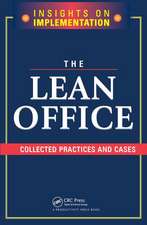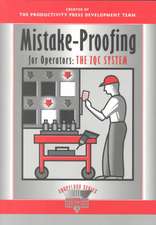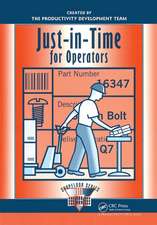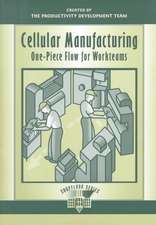Kanban for the Shopfloor: The Shopfloor Series
Autor Productivity Press Development Teamen Limba Engleză Paperback – 15 feb 2002
Kanban for the Shopfloor provides a working manual for those seeking to implement this method of production control in any operation. It defines the various terms and methods employed in kanbans, and illustrates how when adhered to, kanban is an element of continuous improvement that ultimately leads to the ideal of one-piece flow."
In addition to reducing the waste of overproduction, kanban will help your company increase flexibility to respond to customer demand, coordinate production of small lots and wide product variety, and simplify the procurement process.
About the Shopfloor Series: Put proven improvement tools in the hands of your entire workforce!
Progressive shopfloor improvement techniques are imperative for manufacturers who want to stay competitive and to achieve world class excellence. And it's the comprehensive education of all shopfloor workers that ensures full participation and success when implementing new programs. The Shopfloor Series books make practical information accessible to everyone by presenting major concepts and tools in simple, clear language and at a reading level that has been adjusted for operators by skilled instructional designers. One main idea is presented every two to four pages so that the book can be picked up and put down easily. Each chapter begins with an overview and ends with a summary section. Helpful illustrations are used throughout.
Other topics in the Shopfloor Series: Kanban, 5S, Quick Changeover, Mistake-Proofing, Just-in-Time, TPM, Cellular Manufacturing
Din seria The Shopfloor Series
-
 Preț: 228.89 lei
Preț: 228.89 lei -
 Preț: 256.68 lei
Preț: 256.68 lei -
 Preț: 255.80 lei
Preț: 255.80 lei -
 Preț: 264.80 lei
Preț: 264.80 lei -
 Preț: 256.34 lei
Preț: 256.34 lei -
 Preț: 256.63 lei
Preț: 256.63 lei -
 Preț: 256.63 lei
Preț: 256.63 lei -
 Preț: 302.28 lei
Preț: 302.28 lei -
 Preț: 243.78 lei
Preț: 243.78 lei -
 Preț: 412.11 lei
Preț: 412.11 lei -
 Preț: 242.29 lei
Preț: 242.29 lei -
 Preț: 301.13 lei
Preț: 301.13 lei -
 Preț: 314.21 lei
Preț: 314.21 lei -
 Preț: 302.66 lei
Preț: 302.66 lei -
 Preț: 315.40 lei
Preț: 315.40 lei -
 Preț: 311.69 lei
Preț: 311.69 lei - 15%
 Preț: 2379.67 lei
Preț: 2379.67 lei - 9%
 Preț: 2539.83 lei
Preț: 2539.83 lei - 15%
 Preț: 2373.18 lei
Preț: 2373.18 lei
Preț: 300.16 lei
Nou
Puncte Express: 450
Preț estimativ în valută:
57.45€ • 62.43$ • 48.29£
57.45€ • 62.43$ • 48.29£
Carte tipărită la comandă
Livrare economică 22 aprilie-06 mai
Preluare comenzi: 021 569.72.76
Specificații
ISBN-13: 9781563272691
ISBN-10: 1563272695
Pagini: 120
Ilustrații: illustrations
Dimensiuni: 178 x 254 x 7 mm
Greutate: 0.22 kg
Ediția:1
Editura: Taylor & Francis
Colecția Productivity Press
Seria The Shopfloor Series
Locul publicării:Oxford, United Kingdom
ISBN-10: 1563272695
Pagini: 120
Ilustrații: illustrations
Dimensiuni: 178 x 254 x 7 mm
Greutate: 0.22 kg
Ediția:1
Editura: Taylor & Francis
Colecția Productivity Press
Seria The Shopfloor Series
Locul publicării:Oxford, United Kingdom
Public țintă
Professional and Professional Practice & DevelopmentCuprins
Publisher’s Message -- Getting Started -- The Purpose of This Book -- The Basis of This Book -- Two Ways to Use This Book -- How to Get the Most Out of Your Reading -- An Overview of the Contents -- Chapter. Introducing Key Terms and Benefits of Kanban -- What Is Kanban? -- The Pull System and Waste Reduction -- What Will Make Kanban Successful? -- Integrating Kanban with MRPII -- Pilot or Plantwide Implementation -- How Will Kanban Change What You Are Doing Now? -- What Are the Benefits of Kanban? -- Kanban and Your Company -- Kanban and You -- In Conclusion -- Summary -- Reflections -- Chapter 2. The Basics of Kanban: Functions, Rules, and Types of Kanban -- The Differences Between Kanban and Conventional Ordering Systems -- Reordering Point Method and Kanban -- Production Work Orders and Kanban -- MRP II -- A Summary of Push versus Pull -- Functions of Kanban -- To Serve as the Autonomic Nervous System for Just-in-Time Production -- To Improve and Strengthen the Factory -- Rules of Kanban -- Rule 1: Downstream Processes Withdraw Items -- Upstream Processes -- Rule 2: Upstream Processes Produce Only What Has Been Withdrawn -- Rule 3: Only 100 Percent Defect-Free Products Are Sent to -- Next Process -- Rule 4: Level Production Must Be Established -- Rule 5: Kanbans Always Accompany the Parts Themselves -- Rule 6: The Number of Kanbans Is Decreased Gradually Over Time -- Types of Kanban -- Transport Kanbans -- Production Kanbans -- In Conclusion -- Summary -- Reflections -- Chapter 3. Phase One: Scheduling Kanban -- How Many Kanbans Do You Need? -- Takt Time -- How Many Operators Are Needed? -- Line Balancing -- Full Work -- Load Leveling or Smoothing—Heijunka -- Level Production Compared to Shish-Kabob Production -- In Conclusion -- Summary -- Reflections -- Chapter 4. Phase Two: Circulating Kanban -- When Do You Produce? -- What Do You Replenish? -- When Do You Pull? -- Where Can You Pull From? -- What Do You Pull? -- What Belongs on a Kanban Card? -- How Do You Attach Kanban Cards? -- Steps for Circulating Kanbans -- Rules for Circulating Kanbans -- Rules for Transport with Kanbans -- Supermarkets -- Water Beetles and Milk Runs -- In Conclusion -- Summary -- Reflections -- Chapter 5. Phase Three: Improving with Kanban -- Fine-Tuning Production by Reducing Kanbans -- Kanban Highlights Abnormalities -- Reducing Kanbans Reduces Stock -- Kanban As a Visual Control System -- What Is the Essence of Control? -- Five Important Steps in Creating Visual Controls -- Triangle Kanban -- Other Types of Kanbans -- Kanban and Suppliers -- In Conclusion -- Summary -- Reflections -- Chapter 6. Reflections and Conclusions -- A Kanban Implementation Summary -- Reflecting on What You’ve Learned -- Opportunities for Further Learning -- Conclusions -- Additional Resources Related to Kanban -- Books and Videos -- Newsletters -- Training and Consulting -- Website -- About the Productivity Press Development Team.
Notă biografică
Productivity Press Development Team
Recenzii
"An outstanding battle manual to start implementing kanban."
— Ron Fardell, Director, Lean Manufacturing, GDX Automotive, June 2004
"Kanban for the Shopfloor provides the reader with the framework for implementing kanban in any operation. It provides a nomenclature for various terms of kanbans, and illustrates how kanban is an element of continuous improvement that leads to the ideal of one-piece flow."
Tim Rayburn, Director, Continuous Improvement, ESG Chiller Products, York, June, 2004
"The three main strengths of this book are:the simple, plain language, the Chapter 6 summary list that can be used as an excellent check sheet for kanban implementation, the explanation of the role kanban serves in lean production."
— BJ Fontaine, Mgr of Manuf. Eng., NASSCO (Nat'l Steel & Shipbuilding Co.), June 2004
— Ron Fardell, Director, Lean Manufacturing, GDX Automotive, June 2004
"Kanban for the Shopfloor provides the reader with the framework for implementing kanban in any operation. It provides a nomenclature for various terms of kanbans, and illustrates how kanban is an element of continuous improvement that leads to the ideal of one-piece flow."
Tim Rayburn, Director, Continuous Improvement, ESG Chiller Products, York, June, 2004
"The three main strengths of this book are:
— BJ Fontaine, Mgr of Manuf. Eng., NASSCO (Nat'l Steel & Shipbuilding Co.), June 2004
Descriere
Kanban is the name given to the inventory control card used in a pull system. The primary benefit of kanban is to reduce overproduction, the worst of the seven deadly wastes. A true kanban system produces exactly what is ordered, when it is ordered, and in the quantities ordered. Kanban for the Shopfloor provides a working manual for those seeking to implement this method of production control in any operation. It defines the various terms and methods employed in kanbans, and illustrates how when adhered to, kanban is an element of continuous improvement that ultimately leads to the ideal of one-piece flow."

















